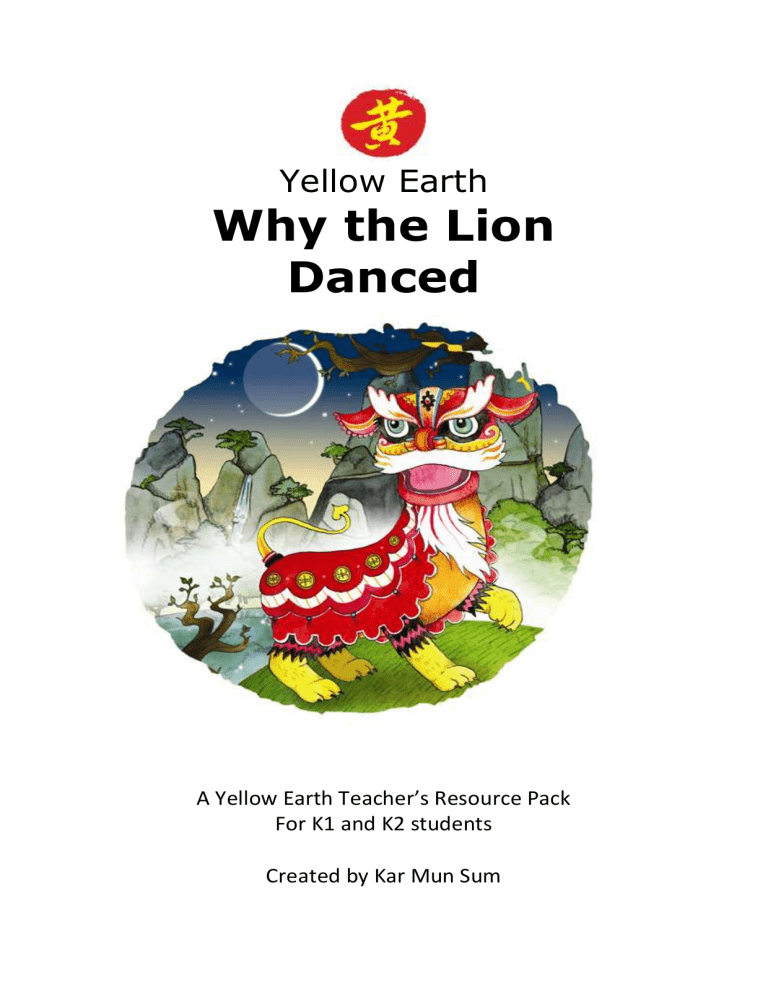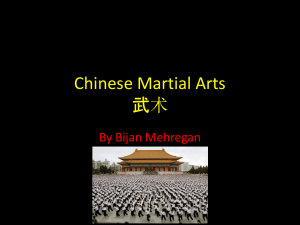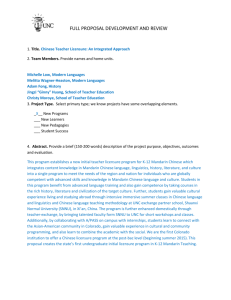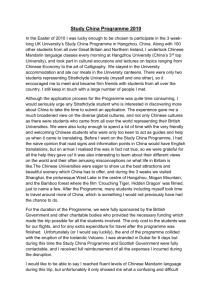WHY THE LION DANCED - Yellow Earth Theatre

Yellow Earth
Why the Lion
Danced
A Yellow Earth Teacher’s Resource Pack
For K1 and K2 students
Created by Kar Mun Sum
CONTENT
1 Introduction
2 Language
3 Idioms
4 Migrants
5 Takeaways in the UK
6 Lunar New Year Traditions
7 Zodiac
8 Chinese Instruments
9 Martial arts
9 How to make a Lion costume
10 Lion mask
2
INTRODUCTION
Yellow Earth is a Londonbased touring theatre company. The company was established in 1995 by five
British East Asian performers to raise the profile of British
East Asian theatre.
Yellow Earth tours nationally and internationally, and produces quality ensemble physical work, using performing traditions of east and west and to celebrate the meeting of different cultures.
Over the years the company has developed a very strong education and outreach programme visiting schools up and down the country with our popular storytelling and shadow puppet workshops. Chinese New Year is the busiest time for our schools work and we wanted to bring the best of our performance work and education work together to offer young people a chance to celebrate Chinese New
Year 2011 and experience the vibrant and rich culture of the Chinese people.
We hope you will find this resource pack useful and give you ideas for the classroom
– Gong xi, xin nian hao! Happy New Year
Kumiko Mendl
Director
Yellow Earth
Yellow Earth Theatre
20 Rupert Street
London W1D 6DF
T: 020 7734 5988 E: education@yellowearth.org.uk www.yellowearth.org
Registered in England no. 3045132; Registered charity no. 1047991; VAT no. 740148849
3
LANGUAGE
In the play you will hear two different Chinese languages : Cantonese and Mandarin.
We decided to include both because although your school may be teaching
Mandarin, still the majority of Chinese people resident in the UK speak Cantonese.
Aunty in the play is from Beijing and is a very close friend of Nainai who is from Hong
Kong. In China there are up to 400 estimated different dialects and languages – it’s a very big country. Mandarin is the national dialect or the main language of China.
Over 90% of Chinese people speak Mandarin, but also may very likely speak another dialect. Cantonese is the main language used in Hong Kong and surrounding areas.
Suggested Activities
1.
Listen to these two clips of a song from the Disney cartoon film,
Mulan. Do they sound the same? How are they different?
Mandarin – http://www.youtube.com/watch?v=AFycchFzHP8
Cantonese – http://www.youtube.com/watch?v=5SLJJc8siyU
2.
In the play, see if you can tell which characters are speaking Mandarin and which are speaking Cantonese.
(Answer – Aunty speaks Mandarin while Nainai and the Dad speak
Cantonese)
3.
Learn some simple Mandarin (numbers from 1 to 5). How is this different from English? The strokes build up one word, while in
English letters of the alphabet are the building blocks for words.
One
一 yi
二 er
Two
三 san
Three
四 si
Four
Five
五 wu
4
IDIOMS
Chinese Idioms or Chengyu are short sayings usually consisting of four characters.
Unless you know the story and its common usage, a Chengyu will sound like random nonsense.
Suggested Activities
1.
Nainai uses several interesting idioms or phrases in the performance.
Can you figure out what she means in some of them? i.
“I hear and I forget. I see and I remember. I do and I understand.” ii.
Meaning: Physically trying something out or experiencing it is the key to understanding it fully and learning it.
“Everything has its beauty but not everyone sees it.”
Meaning: Not everyone can appreciate the inner beauty that exists in everything – people may have different opinions.
2.
Play Pictionary with literal translations of these sayings and then work out with the class what some of the meanings are. Pictionary: Divide the class into two groups. In one minute, a representative from group
A has to draw on the board to get his group to guess as many of the literal meanings as possible. Once the time is up, it’s group B’s turn.
This goes on until all the phrases have been guessed.
Here is a list of some interesting idioms: i.
愛屋及烏
ai wu ji wu
Literal Translation: If you love the house, you have to love the crow on the roof too.
MEANING: If you love someone, you love everything about him. ii.
以卵 击 石
yi luan ji shi
5
Literal translation: Dashing an egg against a rock.
MEANING: To do something that is as futile and useless as trying to hit a rock with an egg. iii.
僧多粥少
zeng duo zhou shao
Literal Translation: Many monks, too little porridge.
MEANING: There isn’t enough to go around. iv.
開門見山
kai men jian shan
Literal Translation: Open the door and see mountains.
MEANING: To come straight to the point, no beating around the bush. v.
對牛彈琴
dui niu tan qin
Literal Translation: Playing the piano to a cow.
MEANING: To talk about something that is not suitable to someone, like how a cow is not an appropriate audience for piano playing. www.cuppapoint.wordpress.com
6
IMMIGRANTS
In the three decades after the Second World War, there was a period of mass immigration into Britain. These immigrants mainly consisted of British citizens who were natives of former British colonies such as the West Indies, South, East and
South-East Asia and West and East Africa, collectively known as the New
Commonwealth. These were people who left their homes and countries behind in search of a better life and more opportunities. Tom mentions that his mother is back in Hong Kong visiting his sick grandmother, so Tom’s parents are a good example of
Hong Kong immigrants.
Suggested Activities
1.
Watch a documentary of animals migrating:
Wildebeest migration by the National Geographic http://www.youtube.com/watch?v=HYM6LqDJLiM
Discuss the reasons and the effects of such a move. How will it feel to migrate from one place to another? Is the journey difficult?
2.
Hunter, fire and earthquake game: students get into groups of 3s (2 of them join hands and represent Trees, the third is a Rabbit squatting between the two). As the teacher calls out different catastrophes
(Fire, Hunter, Earthquake), the students have to react. i.
Fire: the Rabbit remains in place while the Trees have to run around and find a new Tree and Rabbit to group with. ii.
Hunter: the Trees stay in place, while the Rabbits have to all switch homes/groups. iii.
Earthquake: everyone has to run around and find a new group.
7
TAKEAWAYS IN THE UK
The people in post-war Britain wanted a change in terms of food. They were interested in the new and the exotic and Greek, Indian and Italian became popular.
Chinese food especially came into high demand both for its cheapness and for its interesting and different ingredients, taste, and presentation. Many immigrants from
Hong Kong therefore came to Britain to set up restaurants, and the idea of a Chinese takeaway was born. Wen is the owner of one such Chinese takeaway.
Suggested Activities
1.
Learning how to use chopsticks:
Game: you have to pick up as many bits of screwed up paper as you can with chopsticks.
2.
Create a Chinese takeaway in your role-play corner where children can create their own menus. You could extend this by cooking some simple dishes as mentioned in the play.
Starters
Prawn Crackers
8
Spring Rolls
Salt and Pepper King Prawns
Main Dishes
Sweet and Sour Chicken
Crispy Aromatic Duck
Beef in Black Bean Sauce
Rice and Noodles
Egg Fried Rice
Chow Mein
Crispy Noodles
Recipe for Egg Fried Rice
Ingredients
1 cup cooked rice, cooled
2 eggs
1/3 cup peas
2 spring onions, chopped
1 teaspoon cooking oil
A pinch of salt and white pepper
1 teaspoon soy sauce
Instructions
Crack open and beat the eggs until well mixed. Heat a pan and add the oil. When the pan gets hot, add the rice and fry for about 5 minutes. Add the peas and spring onions. Mix them well together and season to taste with the salt, pepper and soy sauce. Fry for about another minute, then push the rice to a side, and pour the eggs in.
When the egg is half-cooked, break it up and start mixing the rice in.
Fry for another 2-3 minutes. Serve hot.
9
LUNAR NEW YEAR TRADITIONS
The Chinese New Year is celebrated on the first day of the First Moon of the lunar calendar.
It is a time for family reunions, and for visiting friends and relatives.
Tom mentions, “It’s New Year’s Eve so we’ve done lots of cleaning so we can soak up all the good luck of the New Year tomorrow. Sweep out the old and welcome in the new! N ǎ inai’s very keen on all the New Year traditions. Like making me have a good wash so I can soak up lots of good luck tomorrow.”
Some of the New Year traditions include: annual housecleaning, wearing new clothes, making papercuts for decorations and eating traditional New Year delicacies. Many also write Spring Couplets, or Chun Lian, like Tom’s parents. Spring
Couplets are expressions of good wishes for the family written on red scrolls of paper with black ink and a brush. Children also receive many hongbaos, or red packets, which are red envelopes filled with good luck money.
Suggested Activities
1.
Create a New Year decoration together! Do simple papercuts with the class. A good example is the word for double happiness in
Mandarin: http://www.youtube.com/watch?v=dTnyMjiyWk&feature=player_embedded. But any pattern will do.
2.
Buy a pack of melon seeds, a New Year delicacy. Let everyone taste some and try cracking them open with their teeth.
3.
Aunty sings a Chinese New Year song. Share a video with English lyrics: http://www.youtube.com/watch?v=-bpRaTBj6Q0
Encourage a singalong session, with the students singing the chorus.
CHORUS (romanized):
Gong xi, gong xi, gong xi ni ya
Gong xi, gong xi, gong xi ni.
10
ZODIAC
The Chinese Zodiac is calculated using the Chinese Lunar Calendar. Each cycle is divided into twelve years, and there is an animal representing each year. The twelve animals, in order, are: Rat, Ox, Tiger, Rabbit, Dragon, Snake, Horse, Ram, Monkey,
Rooster, Dog, and Pig.
Suggested Activities
1.
Tell the story of the Zodiac and how those animals came to represent the twelve years in each cycle. An example of the story
(there are many variations): http://www.topmarks.co.uk/chinesenewyear/zodiacstory.aspx
2.
Group the students up according to their Zodiac animal sign, and do paper plate masks for the animal. For example, 2005 would be the year of the Rooster.
3.
Do a word search puzzle for the twelve animals of the Zodiac
11
G
E
I
R
J
T
D
Q
H
A
M
WORD SEARCH
Can you find the twelve animals of the Zodiac?
DRAGON
TIGER
DOG
OX
SNAKE
RAM
R
K
G
J
W
Q
A
W
Y
O
J
A
M
H
A
R
E
T
Z
E
Y
N
G
N
A
P
B
S
K
V
K
B
D
O
X
W
R
N
H
H
B
N
C
H
N
B
V
A
K
Y
O
G
O
Z
G
X
L
K
U
H
X
R
J
M
E
T
RAT
HORSE
MONKEY
F
G
S
L
E
B
Y
I
S
K
A
Y
L
E
R
A
H
W
O
R
L
W
R
O
O
I
Q
S
J
E
R
S
T
T
I
D
P
W
D
C
I
G
E
P
PIG
HARE
ROOSTER
L
K
S
O
G
F
R
M
K
R
B
12
CHINESE INSTRUMENTS
Aunty can play many Chinese instruments. Some of these include: Moon guitar, bamboo violin, bamboo flute, string violin, gourd pipes, lute, clarinet, zither, drums and gongs.
(From L-R) Pipa, Ruan (Moon guitar), Erhu
Lute: A Pipa is a pear-shaped lute. Its history dates back at least 2000 years.
Moon Guitar: A moon-shaped lute called Ruan that is mostly used in Peking Opera.
Chinese Violin: An Erhu is a two-stringed fiddle that is one of the most popular
Chinese instruments.
Suggested Activities
1.
Show pictures of various Chinese instruments, and discuss with the class about Western instruments that are similar. How are the
Chinese and Western ones alike, and how do they differ?
2.
Make your own instrument. With some cardboard and rubber bands, try and get everyone to make his or her own guitar.
13
MARTIAL ARTS
Nainai is a Black Belt in Kung Fu – does it mean she’s a good fighter? Kung Fu refers to the many different kinds of martial arts that have developed over the centuries in
China. Kung Fu probably originated because of the need for self-defence, hunting techniques and military training in ancient China. The Shaolin temple was an important centre of development for the martial arts and remained so for more than a thousand years. There is a British Kung Fu Association.
Suggested Activities
1.
Watch the Kung Fu Panda training video: http://www.youtube.com/watch?v=EIXRkShk2V4&feature=related
Panda is slow and fat but learns how to fight with Master’s help.
Discuss the training process seen in the video. What is important in
Kung Fu? For example, speed, persistence and having something to fight for. Does size matter? Compare Master to Panda. Think about
Nainai. Does her age mean she’s bad at Kung Fu?
2.
Tai chi is a form of martial arts that has recently adopted by many practitioners as a form of exercise. They practise it every morning to keep fit. Do a simple Tai chi Watermelon exercise together with the class.
Instructions
Imagine you have a huge watermelon. Make the shape with your hands. Cut it in half and slowly, with your palms facing outwards, push half to the friend on your left, and the other half to the friend on your right.
3.
Tell the Snake and Crane story of how Tai chi originated http://thewalkingcircle.com/glossary/taijiquan/ (the short story is under Origins) and get the class to pair up. To get a sense of the movement that was extracted for this martial arts form, A will act as the snake while B will act as the crane. Switch round after 5 minutes.
14
15
16
17
18
19
Print off and colour in.
Illustration by Emily Golden
20






